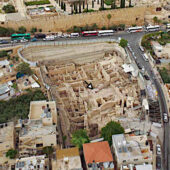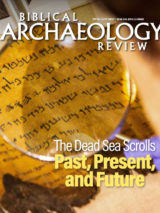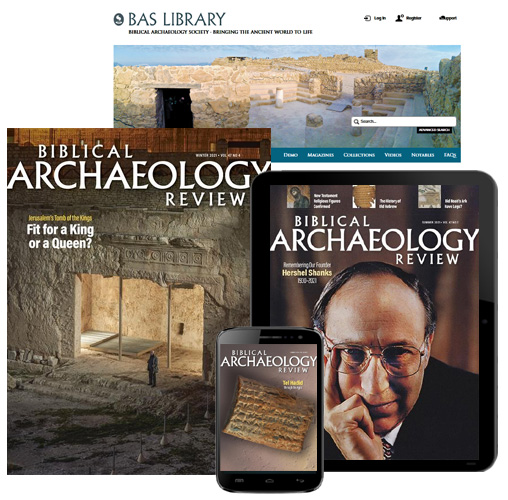Archaeological Views: New Eyeballs on Ancient Texts
<< Back to the BAS Archaeological Technology page.
Read Bruce Zuckerman’s full Archaeological Views column as it appears in BAR.
 The study of ancient texts—especially those that tell us most about the cultures from which the Bible emerged—is on the edge of a revolution. Dramatic new imaging technologies are just now becoming available that allow us to see and reclaim the readings of ancient documents in a manner never before possible.
The study of ancient texts—especially those that tell us most about the cultures from which the Bible emerged—is on the edge of a revolution. Dramatic new imaging technologies are just now becoming available that allow us to see and reclaim the readings of ancient documents in a manner never before possible.
One of these new technologies, called Reflectance Transformation Imaging (RTI), allows for unprecedented control of how an image is displayed, especially in terms of the play of light so crucial to bringing out hidden details that are often the key to proper interpretation. For the first time, control of the light has been placed in the hands of the viewer rather than the photographer. In fact, an RTI image is almost like seeing the real thing—only it’s better.
Pioneers in the development of RTI are two scientists at Hewlett-Packard Labs, Tom Malzbender and Daniel Gelb (the latter the grandson of I.J. Gelb, the great pioneer of Sumerian studies), although others have been working on the technology as well, including our group, the West Semitic Research Project, at the University of Southern California (USC). It involves taking a series of successive images all around an object with the light for each picture situated at a different angle and height but always from about the same distance. This can be done in a light dome or by moving a single light around an object and taking a series of pictures, thus building a virtual light dome. A software program then takes the data from these pictures (a typical set is 32) and builds from them a master image, called a texture-map, which can be displayed on a computer.
The image retrieved—say of a cuneiform tablet or an otherwise hard-to-see seal impression—doesn’t look very interesting when it is first displayed. But then the magic happens. As you move your computer’s cursor around the image with a mouse, it acts like a very powerful virtual flashlight. As the cursor moves, so moves the light. Suddenly, subtle variations on the artifact’s surface are dramatically clarified. And if something is not clear from one angle, that’s okay; you simply move your cursor around to examine it from another angle.
With a couple clicks of the mouse, you can switch from examination with one virtual light source to two. Or, if you prefer, you can switch to a mode called “specular enhancement”—what I like to call the super-shiny effect. This mode makes it appear as though the object is dusted with a virtual layer of silver. Then, as you move the light, the object flashes a mirror-like finish that brings even the tiniest variation of texture into startling clarity.
Yet another mode, “diffuse gain,” can be dialed up so that the contrast is enhanced to a point that even subtle brush strokes on a painting, or ink thicknesses on a Dead Sea Scroll, can be easily picked out.
It’s hard to explain what an RTI image looks like with mere words. And, assuming you are reading BAR on paper, as most people do, I can’t really show you what I mean, either. To be sure, the static illustrations above give you a small sense of what an RTI image can show, but the dynamism of the images is missing—and the dynamics are the most essential part.
Think of it this way: When an ancient reader picked up a clay tablet with cuneiform wedges impressed on its many surfaces, he or she could not read it without moving it. Moving the tablet was essential, because only by changing the play of light by tilting the object in the sun could the reader actually see subtle details and thus the shapes and positions of the wedges.
RTI comes close to replicating this ancient experience. While in an RTI image we can’t move a virtual tablet around in the sunlight, we can move the light around the tablet and achieve much the same effect. In fact, in some respects it’s better because the light can be controlled and manipulated with such precision, and one can zoom in and out on a particular sign or feature at will.
Take a look at one example, a 4,000-year-old cuneiform tablet from our own collection at USC. In the top picture you can just barely see the faint impression of the seal that endorsed the tablet, but you can’t really make out its design, let alone the name of the seal’s owner. But in the RTI image with specular enhancement, the design flashes off the surface dramatically and the signs that make up the name become clear.
Still, to really get a sense of what an RTI image is like, you are going to have to break through the paper barrier. There are a couple of ways you can do this. One of the most fun is through InscriptiFact, an online library we maintain at USC of more than 40,000 digital images of ancient inscriptions and manuscripts—from the earliest cuneiform texts to the Dead Sea Scrolls. There are lots of RTI images in InscriptiFact and, to date, it is the only such database that fully integrates high-resolution RTI images with other sorts of images (even some scanned from glass negatives going back more than a century). You can register to use the database for free at www.inscriptifact.com.
Must-Read Free eBooks
Want more Bible history?
Sign up to receive our email newsletter and never miss an update.
All-Access Pass
Dig into the world of Bible history with a BAS All-Access membership. Biblical Archaeology Review in print. AND online access to the treasure trove of articles, books, and videos of the BAS Library. AND free Scholar Series lectures online. AND member discounts for BAS travel and live online events.
Subscribe Today














[…] In “New Eyeballs on Ancient Texts,” Zuckerman explains why RTI images, created by merging a series of pictures taken with multiple light sources at different angles and distances around an object, are much more powerful than standard digital photographs. When viewed on a computer, RTI images of ancient texts can be virtually manipulated to reveal subtle details invisible to the naked eye, such as the thickness of a letter inked on a Dead Sea Scroll or the impressed signs of an ancient and worn cuneiform tablet. […]